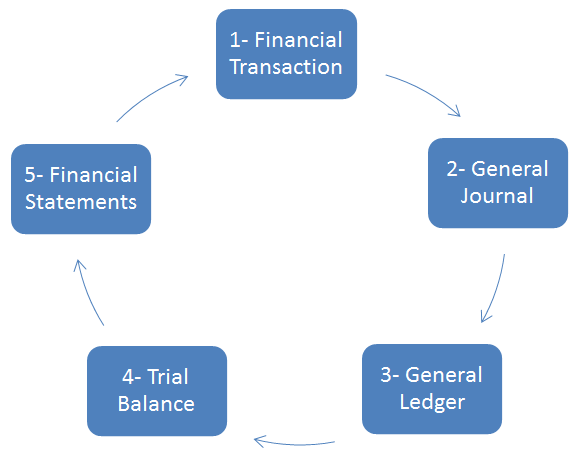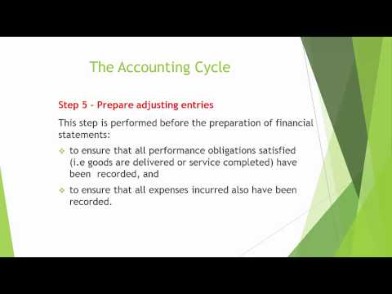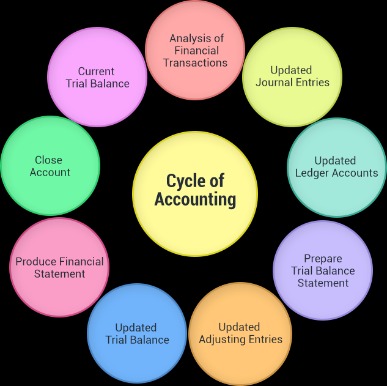Content
- Accounting Topics
- Module 4: Completing The Accounting Cycle
- Business Types
- Why Learn How To The Complete Accounting Cycle?
- The Eight Steps Of The Accounting Cycle
An accounting cycle looks back in time at the end of a designated period (e.g., monthly, quarterly, or annually). There are several steps in the cycle, beginning when a transaction occurs and ending when you close your books. The second step in the cycle is the creation of journal entries for each transaction. Point of sale technology can help to combine steps one and two, but companies must also track their expenses. The choice between accrual and cash accounting will dictate when transactions are officially recorded.A trial balance is considered successful if the debit account balances equal the credit account balances. Even if the unadjusted trial balance is balanced, you must conduct step five as other errors may have occurred. At the end of each accounting period, a company’s accounting department should enter the data from the ledger accounts into a trial balance. This trial balance is also called “the unadjusted trial balance” because it is prepared before adjusted entries—step six—being entered. The accounting cycle is a series of steps used by an accounting department to document and report a company’s financial transactions. The cycle follows financial transactions from when they occur to how they affect financial documents. The accounting cycle happens every accounting period or reporting period for which financial documents are prepared.

Each step in the accounting cycle is equally important, but if the first step is done incorrectly, it throws off all subsequent steps. If you’re unable to track your transactions accurately, the following steps won’t be able to create a clear accounting picture. It’s situations like these that can easily lead to an incorrect trial balance and risk delayed closing of your company books. Having 8 steps in the overall accounting cycle may seem pretty straightforward, but it also means there are 8 chances for your process to go awry.
Accounting Topics
Obviously, business transactions occur and numerous journal entries are recording during one period. Only one set of financial statements is prepared however. Next up, time to double check your work one last time with the help of an adjusted trial balance. This table shows your unadjusted trial balance, your adjusting entries, and your adjusted amounts.At the end of the accounting period, atrial balanceis calculated as the fourth step in the accounting cycle. A trial balance tells the company its unadjusted balances in each account. The unadjusted trial balance is then carried forward to the fifth step for testing and analysis. Regardless, most bookkeepers will have an awareness of the company’s financial position from day-to-day. Overall, determining the amount of time for each accounting cycle is important because it sets specific dates for opening and closing.Read on to learn the accounting cycle definition and steps in accounting process. The ledger is a large, numbered list showing all your company’s transactions and how they affect each of your business’s individual accounts. There are lots of variations of the accounting cycle—especially between cash and accrual accounting types. For simplicity’s sake, we’re going to divide it into six steps.
- No assurance is given that the information is comprehensive in its coverage or that it is suitable in dealing with a customer’s particular situation.
- After the adjusted trial balance is created, the temporary accounts are closed to the permanent accounts with a series ofclosing journal entries.
- The accounting cycle is crucial to your company’s financial health.
- Generally accepted accounting principles and International Financial Reporting Standards both require public companies to utilize accrual accounting for their financial statements.
- The accounting cycle is the process of recording your business’s financial activities consistently and accurately.
- When you have credits and debits from your transactions that don’t balance you have to make corrective adjustments accordingly.
It’s the final step before creating financial statements, so it’s worth triple checking everything. The goal of the accounting cycle steps is to ensure that every cent that changed hands during the accounting period is accounted for properly and reflected in a company’s financial statements. Financial statements serve as the ultimate historical record for a business, and the stakes are high for getting them right.
Module 4: Completing The Accounting Cycle
Once the accounts are balance, financial statements are prepared. By learning the necessary processes and terminology of accounting, you gain fundamental knowledge of a company’s finances. In this article, we discuss the eight steps of the accounting cycle process with examples and explain how it differs from a budget cycle. There are nine main steps in the accounting cycle starting with identifyingbusiness eventsthat need to be recorded. Before anything can be recorded in an accounting system, specific events must be identified. Once your accounts are up-to-date, create financial statements. Financial statements compile your business’s financial information and show your financial health.Luckily, accounting software can easily track all of this information for you. The accounting cycle’s purpose is to ensure that all the money coming into or going out of a business is accounted for. Depending on whom you talk to, the accounting cycle can have anywhere from seven to nine steps, based on how detailed each step is.Transactions are the starting point from which the rest of the accounting cycle will follow. When you close your books, you should get your accounting set up for the next period. File any financial documents from the last period and get rid of old documents that are no longer useful. Use source documents to identify business transactions, such as receipts and invoices. Save these kinds of financial documents to support your records.

Failure to account for all financial transactions can result in lost revenue, or a possible discrepancy on financial statements. The transactions are then posted to the account in the general ledger, which is the list of all the business’ financial accounts, that it impacts, such as rent or wages or marketing. The accounting cycle and budget cycle differ in their timing and focus. The accounting cycle records and reports past company transactions, whereas the budget cycle analyzes the direction and aspirations of a company to project future transactions. Taking into account the information from before, you have debit balances of $400 , $700 , $200 and $100 . This gives you total debits of $1,400 and total credits of $1,400.
Business Types
Analyzing a worksheet and identifying adjusting entries make up the fifth step in the cycle. A worksheet is created and used to ensure that debits and credits are equal.
What are the two sides of accounting?
Double-entry bookkeeping says each accounting transaction has two sides. The general ledger is a record of the two sides of the transaction—a debit and a credit.Knowing how to read and interpret your financial statements can help you stay on top of your business’ finances and strategize for growth. Reconciliation is an accounting process that compares two sets of records to check that figures are correct, and can be used for personal or business reconciliations. The accounting cycle records and analyzes accounting events related to a company’s activities. Adjustments are recorded as journal entries where necessary. Recordkeeping is essential for recording all types of transactions.
Why Learn How To The Complete Accounting Cycle?
Outside parties like banks, investors, and the IRS will look at your financial statements to decide things like whether to give you a loan or whether you paid the right amount in taxes. After the company makes all adjusting entries, it then generates its financial statements in the seventh step. For most companies, these statements will include an income statement, balance sheet, and cash flow statement. Cash accounting requires transactions to be recorded when cash is either received or paid. Double-entry bookkeeping calls for recording two entries with each transaction in order to manage a thoroughly developed balance sheet along with an income statement and cash flow statement. The last stage of the accounting cycle is the closing of temporary accounts.Accruals make sure that the financial statements you’re preparing now take those future payments and expenses into account. If you need a bookkeeper to take care of all of this for you, check out Bench.
Stay Up To Date On The Latest Accounting Tips And Training
The first step in the accounting cycle is to analyze events to determine if they are “transactions” and what their impact is. Transactions include any company purchases that were made, debts paid, debts acquired or revenue acquired from sales. Events that are not considered transactions include creating purchase orders and signing contracts.This content is for information purposes only and should not be considered legal, accounting or tax advice, or a substitute for obtaining such advice specific to your business. No assurance is given that the information is comprehensive in its coverage or that it is suitable in dealing with a customer’s particular situation.If you use accounting software, this usually means you’ve made a mistake inputting information into the system. David has helped thousands of clients improve their accounting and financial systems, create budgets, and minimize their taxes.

This can be done manually but many companies use accounting software for simpler storage recall and organization of transactions. A journal entry has a debit and a credit which relates to how a transaction affects different accounts. Whether an account is debited or credited is determined by how the balance of that account is tracked. We’re an online bookkeeping service powered by real humans. Bench gives you a dedicated bookkeeper supported by a team of knowledgeable small business experts. We’re here to take the guesswork out of running your own business—for good. Your bookkeeping team imports bank statements, categorizes transactions, and prepares financial statements every month.The most crucial part of the balance sheet is the profit and loss statement. As a small business owner, we know you’ve got a lot on your plate. Between managing supplies and satisfying customers, the last thing you need to worry about is an accounting error . With the right processes and tools in place, you can be well equipped to handle any challenge that might come your way. Financial transactions occur, such as selling inventory, buying raw materials, or making lease payments, for example. The final step—the closing process—can occur as a “soft close” throughout the fiscal year, but a “hard close” only happens at the end of the fiscal year. Some textbooks list more steps than this, but I like to simplify them and combine as many steps as possible.Whether your accounting period is done monthly, quarterly, or annually, timing is crucial to implementing the accounting cycle properly. Taking the time to map out plans and dates that coincide with your accounting deadlines will increase productivity and results. For example, a marina that sells boats will need to keep track of each transaction that is made through purchases of equipment, parts, or services rendered over the accounting period. They will also want to take note of important information to make categorizing and following steps easier. At the end of this process, the books are closed to prevent any changes and to restart the income and expense accounts for the next period.You can use the accounting cycle to make accounting easier by breaking your bookkeeping responsibilities down into smaller, bite-sized tasks. The general ledger is like the master key of your bookkeeping setup. If you’re looking for any financial record for your business, the fastest way is to check the ledger. In short, an accounting cycle makes sure that all of the money passing through your business is actually “accounted” for. Thanks to the magic of the internet and automation, the general ledger now lives in the background of the accounting cycle today.